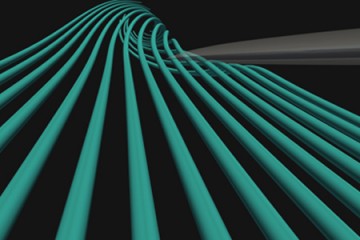When Johns Hopkins and the University of Maryland launched the Maryland Advanced Research Computing Center, or MARCC, in 2015, it was hailed as one of the nation's largest academic high-performance computing centers. Located on the Johns Hopkins Bayview Medical Center campus in East Baltimore and supported by $30 million in state funding, MARCC's swift fiber-optic cable connection lets investigators conduct research on everything from deadly diseases to distant galaxies without having to leave their laboratories or offices. In addition, all participants shared the costs of networking and running a single entity, rather than spending time, money, and space to create their own high-performance computing centers.
"MARCC set Maryland on the map as far as high-performance computing," said Jaime Combariza, a Johns Hopkins computational chemist and MARCC's director. "In fact, its success sparked a renaissance of interest in high-performance computing at Hopkins."
This remarkable progress has led to a new name and expanded mission for the center. MARCC has become ARCH, short for Advanced Research Computing at Hopkins. The reimagined and expanded facility is designed to sustain advanced and data-intensive computing growth with a goal of enabling innovative, dynamic, and life-improving computational discoveries.
"ARCH's basic philosophy is to create and sustain a welcoming place for high-performance computing that will provide resources to foster a collaborative community of researchers in computational science and engineering. Rather than being a siloed collection of clusters for individual PIs, the genius of ARCH is that we pool our resources," says Paulette Clancy, head of the Department of Chemical and Biomolecular Engineering and chair of the Hopkins Research Computing Committee, the faculty oversight group for ARCH.
An innovative feature of the expanded and reimagined facility is this "fair-share" approach which Clancy says allows ARCH to balance the load and need for computing resources at any given time.
"This rather egalitarian philosophy allows you to use my computing cluster when I don't need it, and vice versa, maximizing job throughput," Clancy says, pointing out that this method offers improved economies of scale. "Cooling, power, and system administration are all co-located into one resource."
ARCH's business model is configured so that the funds necessary to provide ongoing hardware support for facility will be provided in perpetuity by participating schools and researchers, ensuring that the facility can offer reliable high-quality service and maintains a "future-ready" stance. In fact, the hardware that forms the computing heart of the facility will need to change roughly every five years.
ARCH's current computing cluster, named "rockfish," was the result of a large National Science Foundation Major Research Instrumentation (MRI) program grant that was used to refresh MARCC's computational hardware, ramping up its capabilities. That award also let MARCC (the nascent ARCH) become a member of NSF's Extreme Science and Engineering Discovery Experiment network, through which scientists across the nation interactively share expertise, data, and computing resources.
Like MARCC, ARCH is structured on a model called "condo computing," in which users buy their own nodes and have them installed in a central cluster. Researchers then not only have priority access to the resources they purchased, but also to those of other researchers in the cluster, if those are not being used.
"Envision rockfish as a leasing office connected to any number of smaller nearby buildings—condos—that all interact together," explains Combariza, director of ARCH. "Any PI can purchase hardware compatible with rockfish which will be integrated into the overall ARCH 'resort.'"
Those condos, like their real-life real estate counterparts, rely on the infrastructure provided by MARCC and ARCH, but the PIs do not "own" them. They are available for high priority use by the researcher who purchased them. All condos become part of the shared pool of resources, providing better efficiency of use for all the ARCH user community, organizers say.
The result is something unique, according to Clancy.
"It is a community where the hardware and software that we share allows us to be greater than the sum of our PI parts," she says.
ARCH management has plans to partner closely with Hopkins Institute for Data Intensive Engineering and Science, or IDIES, to facilitate a seamless process of data-sharing in a shared and shareable resource. For example, they envision that data, methods, and insights created in individual labs connected to ARCH to someday be shared with physicians in clinics and medical centers to improve patient care.
"We see ARCH becoming a critical resource to initiatives here at Hopkins that are developing and applying AI and machine learning to improve the lives of people on our fragile planet," Clancy says.
The advent of ARCH also brings with it the first annual High Performance Computing symposium, to be held in the late fall. Details will be forthcoming once the semester begins, but organizers envision that this will grow into an annual, high-profile event attracting top talent in high-performance computing.
"We envision the HPC symposium becoming a visible and acclaimed annual event that allows students, staff, faculty, visitors, industry representatives, non-profits, etc., to see what's new and exciting in the world of HPC," Clancy says.
Posted in University News
Tagged big data, computer science









